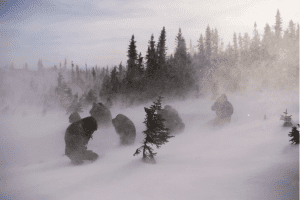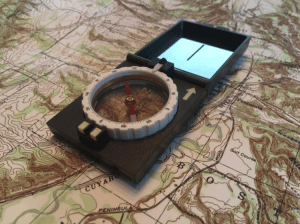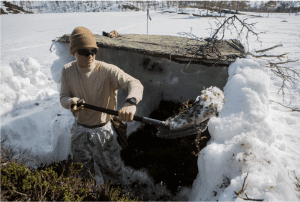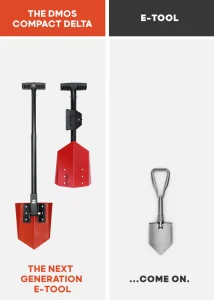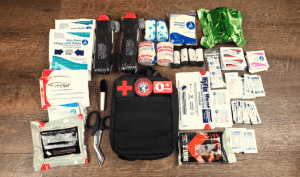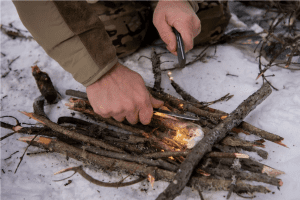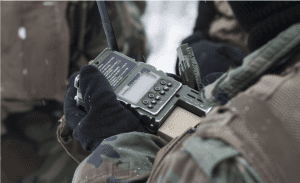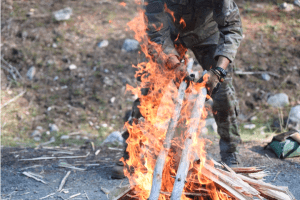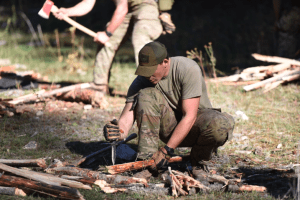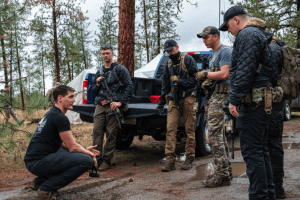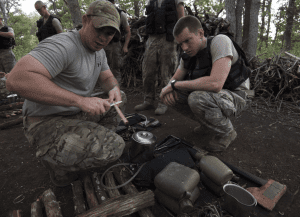Imagine you’re in a situation where you need to leave home fast – a real “bug out” scenario.
This is when having a well-equipped emergency kit in your vehicle becomes a game-changer.
In this article, we’ll guide you through putting together a vehicle emergency kit that’s ready for just about anything.
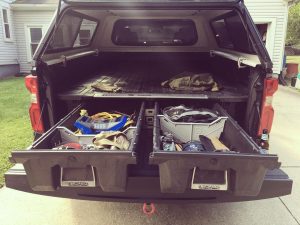
It’s not just about the basics like a spare tire or jumper cables (although those are important!). We’re talking serious gear for serious situations.
What if you had to survive a few days away from home, or travel through uncertain conditions to reach safety? We’ve got you covered.
This guide is for everyone, whether you’re someone who likes to be prepared for the worst or just want peace of mind on your daily drives.
Let’s get your vehicle ready to be more than just transportation. It can be your lifeline in times of need.
Roadside Emergency Kit
In my quest to become more self-reliant during road trips, I’ve gathered a collection of tools and supplies that are essential for handling typical roadside emergencies. In my region, the most frequent issues are vehicles getting stuck, particularly in winter, flat tires, and battery failures.
To be prepared for these situations and to offer help to others, I’ve equipped myself with the necessary gear. The next phase was to find an effective way to store these items. I recently upgraded to a Chevy Silverado truck, which offers limited storage space for such equipment, unless you’re willing to occupy the truck’s cabin with a ton of gear.
The solution came in the form of the Decked truck bed storage system. With the Decked system installed, I found the perfect spot not just for my roadside assistance tools and recovery equipment, but also for outdoor gear, allowing for spontaneous hikes and trail adventures. The following task was to neatly organize these items within the Decked storage unit.
Essential Items for Your Roadside Emergency Kit
- Basic Hand Tools: A set of basic hand tools including screwdrivers, pliers, and an adjustable wrench, to manage minor repairs and adjustments.
- Duct Tape, Spare Hose Clamps, and Tie Wraps: Duct tape for temporary fixes, hose clamps for securing loose parts, and tie wraps for fastening components together.
- Tire Repair Kit and Portable Air Compressor: A tire repair kit for patching up small punctures and a portable air compressor to re-inflate tires on the go.
- Road Flares: Essential for increasing visibility and safety, especially if you’re stranded on the road at night or in low-visibility conditions.
- Auto Fire Extinguisher: A small, vehicle-appropriate fire extinguisher to handle any minor fires that may occur.
- Low Profile Floor Jack: Replace the standard scissor jack with a low profile floor jack. These are easier and safer to use, and they make changing tires much quicker.
- Jumper Cables and Portable Jump Box: Essential for dealing with a dead battery. A portable jump box is a handy backup if another vehicle isn’t available for a jump start.
- Vehicle Entry Kit: In case of locking keys inside the car, a basic entry kit can save time and the cost of a locksmith.
- Vehicle Recovery Strap (Tow Strap): Useful for getting your vehicle out of a bind or helping others in distress.
- MaxTrax Traction Boards: These are invaluable for gaining traction and getting out of snow, sand, or mud, especially in off-road or adverse weather conditions.
Vehicle Medical Kit
When building a vehicle emergency kit, special attention should be given to the medical kit, especially for dealing with traumatic injuries that might occur due to car accidents or rare but severe incidents like active shooter situations.

Key Components of a Vehicle Medical Kit
Multiple Tourniquets
CAT-7 Tourniquet: It’s a combat-proven tourniquet, known for its effectiveness in stopping severe bleeding from limb injuries. It’s crucial to carry more than one, as multiple injuries may occur, or a second attempt might be needed to stop the bleeding effectively.
Hemostatic Gauze
This gauze is treated with substances that rapidly help in blood clotting. In situations where a tourniquet can’t be used (like injuries in the neck, shoulder, or groin), hemostatic gauze can be a lifesaver.
Chest Seals
For injuries that penetrate the chest (like gunshot wounds or severe shrapnel injuries), a chest seal can be vital. These seals help in preventing air from entering the chest cavity during breathing, which can be crucial in preventing a collapsed lung (pneumothorax).
Additional Items to Consider
- Basic First Aid Supplies: Bandaides, antiseptics, pain relievers, and any personal medications.
- Splints: For immobilizing broken bones or sprains.
- Burn Dressings: For treating burn injuries, which can occur in car accidents or fires.
- Trauma Shears: Useful for cutting clothing.
- Gloves: To maintain hygiene and protect yourself from bloodborne pathogens.
Training and Knowledge
Having these supplies is only half the battle. It’s crucial to know how to use them effectively.
Consider taking a basic first aid course, with a focus on traumatic injuries and to keep yourself updated on the latest first aid techniques and recommendations. In addition to the training, periodically review your kit and replace any used or expired items.
A well-thought-out vehicle medical kit, equipped to handle traumatic injuries, is an indispensable part of a vehicle emergency kit. Remember, the best outcome in any emergency situation is partly due to the availability of the right tools and the knowledge to use them effectively.
RELATED – Trauma First Aid Training: Preparing Yourself for the Unexpected
Emergency Communications
Cell Signal Boosters
Struggling with a weak cell signal is a real pain, especially when trying to make calls or navigate using your phone’s GPS. Good signal strength is crucial for GPS apps to function properly.
This became clear to me during a road trip to Northern Michigan with my friend Erik. After installing a Decked system in his Trail Boss truck, we joined an off-roading group, Michigan Overland. Over the weekend, we covered about 160 miles of trails, but cell service was very spotty.
The leader knew the area, which was helpful since our cell reception was inconsistent. Occasionally, we managed to get just enough signal for a quick GPS check.
When Erik and I left the group to head home, navigating out of the remote area became challenging. We kept in touch using our Midland radios in the trucks, but my GPS was useless with just one bar of service. It couldn’t find my location or guide me until we reached the main highway.
That experience was incredibly frustrating. I realized then how much of a difference a device like the weboost Drive Sleek could have made, ensuring reliable cell service in such remote areas.
Best Walkie Talkies For Road Trips
The Midland MXT275 is a rugged little 2-way radio that packs a 15-watt punch, perfect for vehicle communications. It’s part of the Micromobile range and is super compact, so you can fit it almost anywhere.
Midland says the MXT275 can reach up to 50 miles in perfect, open conditions, but living in the wooded areas of Ohio, I’m not expecting that kind of range.
For times when I need communication outside the vehicle, I went with the Midland GXT1000. These compact handheld radios are surprisingly powerful with their 5-watt output, boasting a range of up to 36 miles, though that’s in ideal, open conditions.
The set comes with two handheld units, rechargeable batteries, a charging base, and headsets, all for a reasonable price of $89.99. Plus, the charging station is pretty versatile, offering both AC and 12v charging options, making it convenient for use both in and out of the vehicle.
RELATED – Best SHTF Radios for Disaster Communications
Vehicle Go Bag
In the realm of vehicle preparedness, the concept of a “Vehicle Go Bag” is crucial. This specialized kit, designed to be compact yet comprehensive, acts as your quick-grab solution in emergencies.
At its core is the ‘Truck Gun’ – a compact firearm for personal defense, accompanied by essential guidelines on legality and training.
The bag itself is versatile, doubling as a backpack or duffel, discreetly accommodating your firearm.
Beyond this, it’s packed with essentials like a rain jacket, hat, and spare socks, alongside a small survival kit, a secondary medical kit, and some spare cash, ensuring you’re ready for any unexpected scenario.

The go bag should sustain you until you reach a safe location or help arrives.
Truck Gun
A truck gun (SBR, PCC, or a broken-down AR) should be part of your kit, considering the legalities and your proficiency with it.
When deciding on the type of truck gun, here are a few things to consider.
A compact rifle chambered in 5.56 offers significantly more stopping power than a pistol caliber carbine. However, every advantage comes with a downside. A 10.5” 5.56 rifle without a suppressor is like throwing a flash bang out in front of your rifle, causing temporary deafness and blindness to the shooter and those nearby.
Furthermore, the 5.56’s effectiveness heavily relies on its velocity. Reducing the velocity decreases its impact. Specialty ammunition, like Mk262, can compensate for this but at the expense of higher costs.
In contrast, a pistol caliber carbine is quieter than an unsuppressed pistol, especially when used in combination with a linear compensator. The PCC’s mild recoil makes delivering multiple rounds on target much easier to accomplish.

The question arises: would you rather have three precise 9mm shots, each inflicting damage to the threat, or one accurate 5.56 shot with two others landing close by?
If body armor isn’t a concern, and the engagement is within 25 meters using hollow-point bullets, the PCC may be preferable over the 5.56 rifle.
However, this all changes with the presence of body armor and/or engagements beyond 25 meters. That said, this is going to be different from person to person and dependant on your area of operation and perceived threats.
We’ll address this in more detail in a later article.
RELATED – Top Tactical Carbine Courses To Take
Conclusion
Building a vehicle emergency kit is an ongoing process.
Start with the essentials and expand as your budget allows.
Remember, this kit we mentioned above is not exhaustive; tailor it to your specific needs, considering your usual routes, destinations, and personal circumstances.
To truly master all the essentials of being prepared, visit the Tac-Skills course finder. Empower yourself with knowledge and skills that can make a significant difference in any situation.











